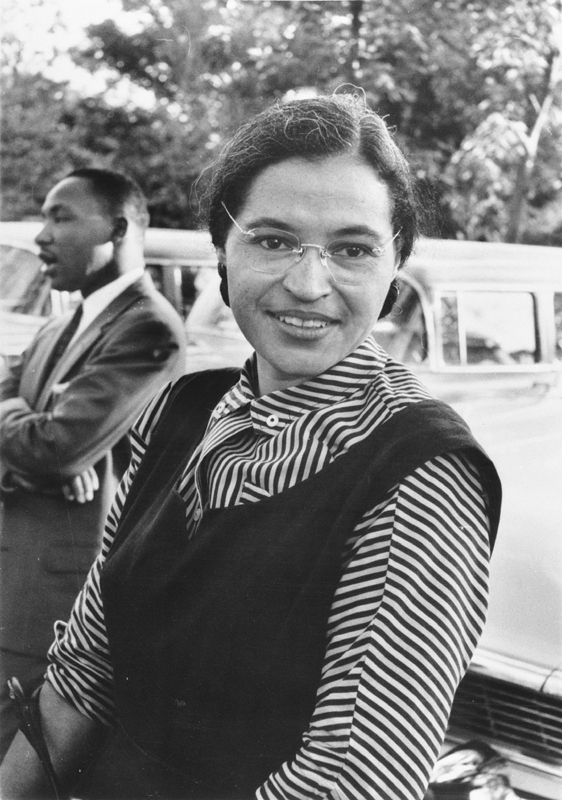Winner of the Fall 2016 StMU History Media Award for
Best Article in the Category of “People”
When one hears the name Rosa Parks, one is taken back in time to 1955, when a brave woman decided not to give up her seat. Rosa Parks was a woman who believed that the color of a person’s skin should not dictate the way a person is treated. Rosa Parks was a civil rights activist.

James McCauley, a skilled carpenter and stonemason, and Leona McCauley, a school teacher, were married on April 12, 1912, in Tuskegee, Alabama. Two months before their first anniversary, on February 4, 1913, in Tuskegee, Alabama they welcomed a daughter into their lives and named her Rosa Louise McCauley. On August 20, 1925 the McCauleys welcomed their son, Sylvester McCauley, into their family.1 The McCauley family decided to move to Abbeville, Alabama where they lived with James’s parents, sharing a bedroom with a large extended family. Rosa’s mother grew tired of the living arrangements and without her husband James around to support the family, she made the decision to leave. In 1917, when Rosa was only 4 years old, Leona took her two young children and moved back to Pine Level, Alabama where she and the children stayed with her parents. Rosa saw her father a year later when she was five and then again when she was an adult and married.2
Rosa received most of her education from her mother and grandfather as a little girl. In 1924, when Rosa was eleven years old, her mother enrolled her in the Montgomery Industrial School for Girls. The school was for African American girls seeking education; they were taught by mostly white teachers. The school focused on the domestic sciences of cooking, sewing, and housekeeping. The white people of the town accused the teachers of teaching racial equality and referred to them as Yankee black lovers. The school was later burned down by the Ku Klux Klan as they grew more powerful.3 After the Montgomery Industrial School for Girls closed in 1928, fifteen year old Rosa attended Booker T. Washington High School for her ninth grade year. She wanted to be a teacher just like her mother, so for her tenth grade year Rosa attended Alabama State Teachers College for Negros. Sadly, she had to drop out of school and return to Pine Level, Alabama to care for her grandmother who had grown ill. When her grandmother died in 1929, Rosa was only 16 years old. She moved back to Montgomery and found her first job making men’s blue denim work shirts at a textile factory. Soon after beginning her job in the factory, Rosa was forced to leave in order to care for her mother who had also grown ill.4 Rosa spent her teenage years cleaning houses and taking in sewing jobs. In 1931, Rosa met Raymond Parks, who worked as a barber and was a member of the National Association for the Advancement of Colored People (NAACP).5 The two fell in love and in December 1932, Rosa and Raymond were married. Raymond encouraged his new bride to go back to school so as to finish her education. This meant so much to her, and so Rosa completed her studies and received her high school diploma in 1934.6

By 1943 all buses in the South had long been segregated and had followed an extensive set of rules set forth by the bus drivers. Montgomery, Alabama was no exception to the segregation. All the buses had thirty-six seats; the first ten were reserved for whites only, ten seats in the back of the bus were for African Americans, and as for the sixteen seats in-between, these were for the bus drivers to decide. African Americans were frequently forced to give up their seats for whites and the bus drivers imposed their own segregation rules through the use of guns they carried with them.7
In November of 1943 Rosa boarded a bus in Montgomery, Alabama. African Americans were typically required to enter the bus from the doors located near the back of the bus, but since the bus was extremely crowded, Rosa was forced to enter from the front doors of the bus. The bus driver demanded she get off the bus and enter through the back door and Rosa refused, standing her ground and explaining to the bus driver that since she was already on the bus there was no need for her to get off because the back of the bus was already at capacity and she would not be able to enter from the back. The bus driver began tugging at Rosa’s coat to push her off the bus and so she decided to not create more of a scene and exited the bus.8
On December 1, 1955, Rosa headed to work at the Montgomery Fair Department Store on the Cleveland Avenue bus to Court Square. It was a normal day for Rosa, working her regular shift, busy as usual.9 Once work was over, Rosa was tired; her body ached, her feet hurt and were swollen from standing all day. Rosa walked to Court Square to wait for her bus and as soon as the first bus came, she saw that it was packed and decided to wait for the next one. Once the second bus arrived Rosa entered the bus, paid, and sat in the racially neutral middle section behind the movable sign which read “colored.”10 At the third stop, a group of whites entered the bus and since the last front seats were taken, one was left standing. The bus driver turned around and looked at Rosa. Rosa was shocked to see that it was the same bus driver she had had a problem with twelve years earlier. The driver, James F. Blake, began to shout at the passengers, “Move ya’ll, I want those two seats,” meaning he wanted Rosa to give up her seat. Rosa did not get up and Blake went straight to Rosa demanding she give her seat up. When Rosa still would not comply he warned her that he would have her arrested, to which she simply replied, “You may do that.”11
Once police arrived, Rosa was arrested, handcuffed and taken to the police station. At the station, Rosa was finger printed, photographed and placed in a cell. While in jail Rosa was treated badly. She requested a drink of water and a police officer yelled out to her “for whites only.” She even requested to make one phone call and was ignored. After requesting several times to make her phone call, she was finally given approval and she phoned her husband. Edgar Daniel Nixon, an African-American civil rights leader, paid a one-hundred dollar bond to bail Rosa out of jail. Rosa worked with Nixon as a branch secretary. In speaking with Nixon about the incident, Rosa decided to file suit and make a civil rights case regarding Montgomery’s bus segregation.12 On the day of trial, December 5, 1955, African Americans in Montgomery boycotted the buses and Rosa was found guilty of breaking segregation laws.13 The boycott proved to be a large protest, and it led to the formation of the Montgomery Improvement Association (MIA).14 On November 13, 1956, the Supreme Court ruled that bus segregation was unconstitutional and the boycott ended on December 20, 1956.15 Rosa became known as the mother of the Civil Rights Movement.16

Rosa Parks traveled and supported civil rights events and causes and even wrote an autobiography, “Rosa Parks: My Story.” In 1999, for all her accomplishments and beliefs as a strong African American, Rosa was awarded the Congressional Gold Medal, which is the highest honor in the United States presented to a civilian.17 On October 24, 2005, at the age of 92, Rosa Parks passed away. She became the first woman in the nation’s history to lie in state at the U.S. Capitol.18
Rosa Parks left a major impact on America and made history. She stood up for what was right for herself and for the people, not because of the color of their skin but because she believed that everyone should be treated equally. She boarded a bus at the end of a long work day, tired and wanting to go home, not realizing that she would forever change segregation in America. Rosa Parks was a very noble woman and she left behind a legacy that will never be forgotten.
- Salem Press Biographical Encyclopedia, January 2016, s.v. “Rosa Parks,” by Tammy K. Baggett. ↵
- Douglas Brinkley, Rosa Parks (Penguin Group Penguin Putnam Inc., 2000), 20-21. ↵
- Brinkley, Rosa Parks, 28, 29, 36. ↵
- Brinkley, Rosa Parks, 36. ↵
- Brinkley, Rosa Parks, 38. ↵
- Salem Press Biographical Encyclopedia, January 2016, s.v. “Rosa Parks,” by Tammy K. Baggett. ↵
- Brinkley, Rosa Parks, 57. ↵
- Brinkley, Rosa Parks, 58-59. ↵
- Salem Press Biographical Encyclopedia, January 2016, s.v. “Rosa Parks,” by Tammy K. Baggett. ↵
- Brinkley, Rosa Parks, 105. ↵
- Brinkley, Rosa Parks, 106-107. ↵
- Brinkley, Rosa Parks, 73, 108, 109, 111, 113, 114. ↵
- Brinkley, Rosa Parks, 152. ↵
- Brinkley, Rosa Parks, 134. ↵
- Brinkley, Rosa Parks, 152, 170. ↵
- Rosa Parks: “The First Lady of Civil Rights,” Bill of Rights Institute, March 2, 2012, http://billofrightsinstitute.org/rosaparks/. (accessed November 7, 2016). ↵
- Salem Press Biographical Encyclopedia, January 2016, s.v. “Rosa Parks,” by Tammy K. Baggett. ↵
- Salem Press Biographical Encyclopedia, January 2016, s.v. “Rosa Parks,” by Tammy K. Baggett. ↵



79 comments
Grace Bell
This article does a great job of describing Rosa’s background, and what she did for the civil rights movement as a whole. I felt as though I received lots of information about Mrs. Parks that I hadn’t gotten before, which I enjoyed. She is a very inspirational person and may people still look up to her to this day, she is really a true American hero.
Amanda Perez
This article is a good reminder that Rose Park did much more than display great courage. Her actions were recognized nationally and she became a household name. It’s rational to think that her rough upbringing and the great support from her husband contributed to her fearless ways. It is also coincidental that she ran into the same bus driver twice.
Alexis Soto
After reading this Article it came as no surprise as to why it won best Article for People. This was a great read that provided many detailed information about Ms. Rosa Parks from her childhood to personal relationships. It helped humanize a historical figure who was a regular person trying to survive in a cruel world. Rosa Parks unwittingly set the motion for some of the most notable events in American history.
Erin Vento
We’re lucky enough to hear about Rosa Parks in school, but never get a full understanding of who she was as a human- or woman- and not as a historical figure. I really believe you did a good job telling us about her life and giving insight about the bus problem we hadn’t known before. Growing up, it’s important to talk about brave, capable heros we can model ourselves after and Rosa Parks can easily be categorized as one of the most iconic.
Thomas Fraire
Before reading this I had a very broad understanding of who Rosa Parks was. But reading this really helped me understand why she is so inspirational. I really loved this article it empowering for women and people who are standing for something they believe in. I can really see why this article won an award it was just really solid.
Veronica Spryszynski
Outstanding article with details from Rosa’s childhood, to marriage, to adulthood. By reading about her young teenage years I wouldn’t expect such a huge impact from her in the future based on her having to leave school and move to place to place. Even though racial discrimination still exists today we are getting closer and closer to the very end of it. I agree with Rosa’s actions to not give up her seat on the bus because who knows how our world will be today if it wasn’t for that movement. I think Rosa is a very confident and mindful person who risked her life to have equality for everybody.
Rebekah Esquivel
Growing up we always hear about Rosa Parks but are never told her full story. This article was very informative. I find it shocking that the same driver of the bus was the same man she had trouble with twelve years before. I’m sure this greatly influenced her decision to stay seated as to prove her point to not only everyone else but also to that man. She is a very inspirational woman I think she is so brave for what she did for the civil rights movement. I’m glad to see that she was able to see society change and see how her courage helped for the good and made a difference.
Zeresh Haman
This article is awesome. It gave me insight to a part of Rosa Parks’ life that a lot of people don’t know about. Throughout all of the history that I have taken, i have many times heard the story of Rosa Parks refusing to give up her seat, but i have never heard the story of her life. It was so interesting that it was the same bus driver that Rosa had problems with 12 years earlier, was also the one to get her arrested. I have always admired Rosa Parks for her courage to stand up for whats right, I think this article is truly amazing and gives us a look into who Rosa Parks actually was and where she came from.
Josselyn Arrieta-Meraz
As a child I grew up knowing about Rosa Parks and her heroic scene in the bus, but I never actually knew her full history and how she impacted African American Rights. I am glad that after all she went through she was given recognition for what she deserved, not only for her but for African Americans in general, because of her decision and stance she steered history towards a more equal future, a future in which color was not a question, because we are all human. I’m glad I read this article and learned more about a hero in history.
Ernie Sano
Rosa Parks is one of the many staples in American history that represents not only freedom and equality, but the ability to stand up for what one believes in. Her work is often associated with African-American history, as it should, but it is also a representation of what can be accomplished through the strength of will that all humans strive to obtain.